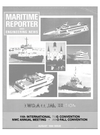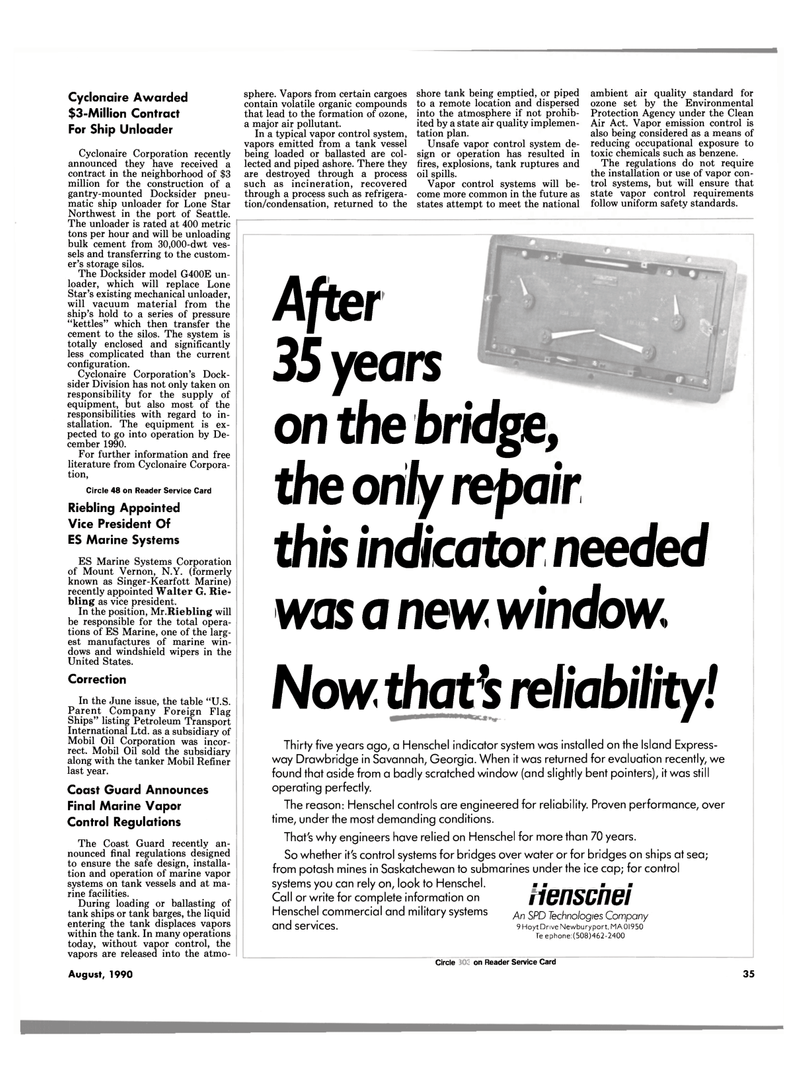
Page 35: of Maritime Reporter Magazine (August 1990)
Read this page in Pdf, Flash or Html5 edition of August 1990 Maritime Reporter Magazine
Cydonaire Awarded $3-Million Contract
For Ship Unloader
Cyclonaire Corporation recently announced they have received a contract in the neighborhood of $3 million for the construction of a gantry-mounted Docksider pneu- matic ship unloader for Lone Star
Northwest in the port of Seattle.
The unloader is rated at 400 metric tons per hour and will be unloading bulk cement from 30,000-dwt ves- sels and transferring to the custom- er's storage silos.
The Docksider model G400E un- loader, which will replace Lone
Star's existing mechanical unloader, will vacuum material from the ship's hold to a series of pressure "kettles" which then transfer the cement to the silos. The system is totally enclosed and significantly less complicated than the current configuration.
Cyclonaire Corporation's Dock- sider Division has not only taken on responsibility for the supply of equipment, but also most of the responsibilities with regard to in- stallation. The equipment is ex- pected to go into operation by De- cember 1990.
For further information and free literature from Cyclonaire Corpora- tion,
Circle 48 on Reader Service Card
Riebling Appointed
Vice President Of
ES Marine Systems
ES Marine Systems Corporation of Mount Vernon, N.Y. (formerly known as Singer-Kearfott Marine) recently appointed Walter G. Rie- bling as vice president.
In the position, Mr.Riebling will be responsible for the total opera- tions of ES Marine, one of the larg- est manufactures of marine win- dows and windshield wipers in the
United States.
Correction
In the June issue, the table "U.S.
Parent Company Foreign Flag
Ships" listing Petroleum Transport
International Ltd. as a subsidiary of
Mobil Oil Corporation was incor- rect. Mobil Oil sold the subsidiary along with the tanker Mobil Refiner last year.
Coast Guard Announces
Final Marine Vapor
Control Regulations
The Coast Guard recently an- nounced final regulations designed to ensure the safe design, installa- tion and operation of marine vapor systems on tank vessels and at ma- rine facilities.
During loading or ballasting of tank ships or tank barges, the liquid entering the tank displaces vapors within the tank. In many operations today, without vapor control, the vapors are released into the atmo-
August, 1990 sphere. Vapors from certain cargoes contain volatile organic compounds that lead to the formation of ozone, a major air pollutant.
In a typical vapor control system, vapors emitted from a tank vessel being loaded or ballasted are col- lected and piped ashore. There they are destroyed through a process such as incineration, recovered through a process such as refrigera- tion/condensation, returned to the shore tank being emptied, or piped to a remote location and dispersed into the atmosphere if not prohib- ited by a state air quality implemen- tation plan.
Unsafe vapor control system de- sign or operation has resulted in fires, explosions, tank ruptures and oil spills.
Vapor control systems will be- come more common in the future as states attempt to meet the national ambient air quality standard for ozone set by the Environmental
Protection Agency under the Clean
Air Act. Vapor emission control is also being considered as a means of reducing occupational exposure to toxic chemicals such as benzene.
The regulations do not require the installation or use of vapor con- trol systems, but will ensure that state vapor control requirements follow uniform safety standards. 35
After 35 years on the bridge, the only repair this indicator needed was a new window.
Now that's reliability!
Thirty five years ago, a Henschel indicator system was installed on the Island Express- way Drawbridge in Savannah, Georgia. When it was returned for evaluation recently, we found that aside from a badly scratched window (and slightly bent pointers), it was still operating perfectly.
The reason: Henschel controls are engineered for reliability. Proven performance, over time, under the most demanding conditions.
That's why engineers have relied on Henschel for more than 70 years.
So whether it's control systems for bridges over water or for bridges on ships at sea; from potash mines in Saskatchewan to submarines under the ice cap; for control systems you can rely on, look to Henschel. •• • •
Call or write for complete information on rlGnSCflGI
Henschel commercial and military systems An SPD Technologies Company and services. 9HoytDriveNewburyport,MA0l950
Teephone (508)462-2400
Circle 245 on Reader Service Card

 34
34

 36
36
